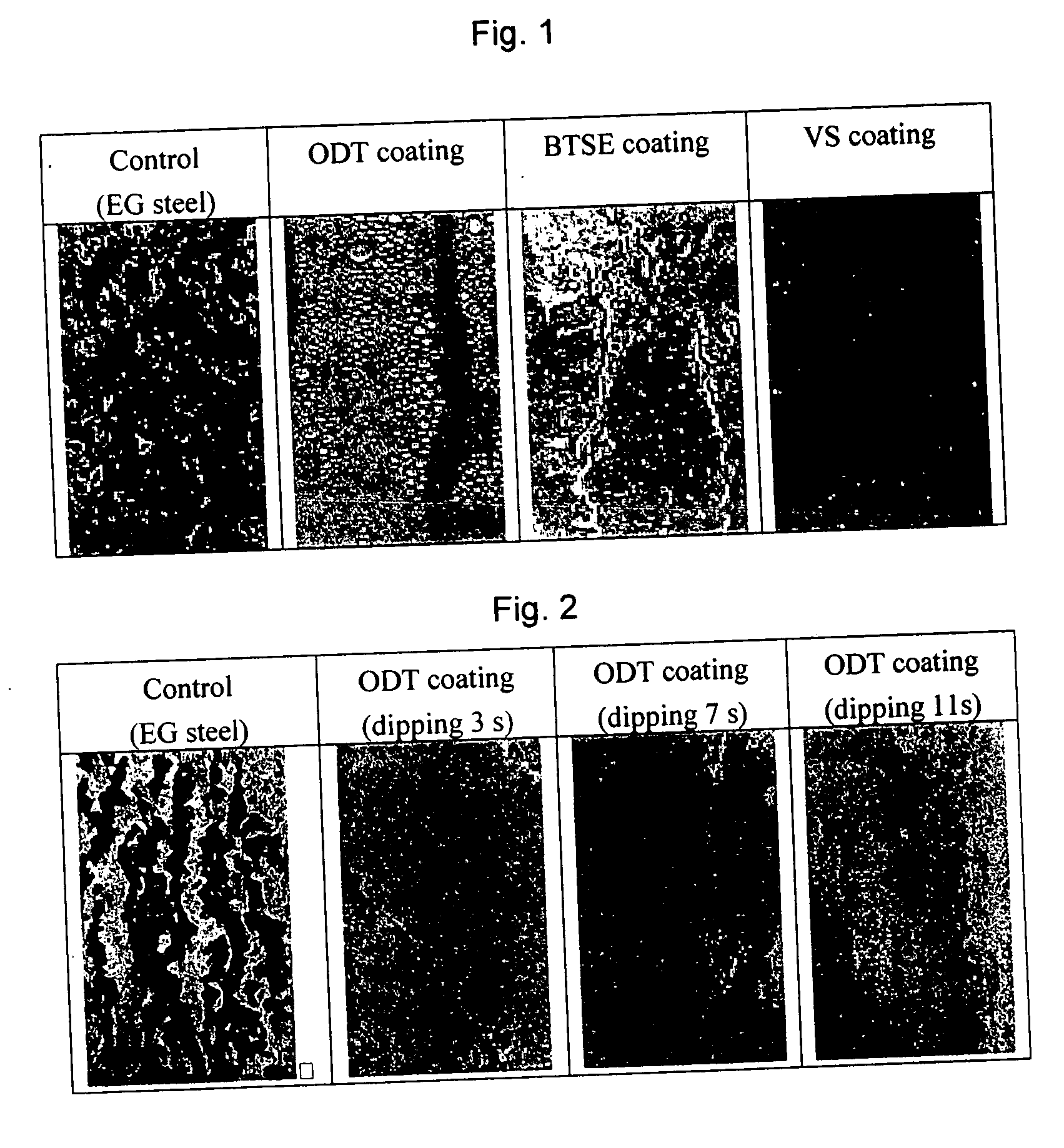Method of protecting metals from corrosion using thiol compounds
a technology of thiol compounds and metals, applied in the direction of superimposed coating process, chemical coating, liquid/solution decomposition chemical coating, etc., can solve the problems of chromium salts, bilayer films are not effective in improving corrosion resistance, and corrosion started as pits, so as to increase the corrosion resistance of galvanized steel, increase the corrosion resistance, and the effect of forming sams
- Summary
- Abstract
- Description
- Claims
- Application Information
AI Technical Summary
Benefits of technology
Problems solved by technology
Method used
Image
Examples
example 1
[0044] In this example, an electro-galvanized (EG) cold-rolled steel (CRS) prepared by Pohang Iron and Steel Company (POSCO) was cut to a small panel with dimensions of 12×7.5 cm. It was coated with 1-octadecanethiol, which can readily form closed-packed SAMs on the zinc-coated steel surface due to the long hydrocarbon chains. The coating was done by immersing the CRS panel in a 0.05 M ODT-in-ethanol (absolute alcohol) solution for 5 minutes. The coated surface was then dried in an oven at 120° C. for 5 minutes. The coating exhibited a light gray color. The coated surface was highly hydrophobic, indicating that the terminal CH3-groups were pointed away from the surface. As shown in Table 1, the water contact angle increased from 72 to 124° due to the coating, and the surface free energy of the coated surface decreased from 45.24 to 34.63 mJ / m2. Tafel studies showed that the ODT coating decreased corrosion current substantially from 49.04 to 8.78 μA / cm2, which was an indication that ...
example 2
[0047] In Example 1, the ODT coating was made by immersing an electrogalvanized CRS panel in a 50-mM ODT-in-ethanol solution for 5 minutes. It is difficult, however, to implement such a long immersion or dipping time in an operating plant. Therefore, it was necessary to conduct tests with much shorter dipping times. In Example 2, EG steel panels with dimension of 12×7.5 cm were immersed in 50-mM ODT-in-ethanol solutions for 3, 7 and 11 seconds. The coated panels were dried in an oven at 100° C. for 2 minutes, and subjected to salt spray tests. The untreated EG steel (control) started rusting in 2 to 4 hours, while the EG steel panels treated with ODT showed little signs of corrosion after 48 hours as shown in FIG. 2. That the EG steel panels treated for such short period of time still showed excellent corrosion resistance indicates that (a) ODT reacts quickly with zinc metal and (b) 10 seconds of dipping time would suffice in a production line.
example 3
[0048] In this Example, effects of using different solvents for ODT were investigated. Three different solvents, i.e., ethanol, ethyl acetate and benzene, were tested. In each experiment, a panel of EG steel was coated by dipping it in a 50-mM ODT solution for 5 minutes. The coated panel was dried in air for a few minutes to allow the solvents to evaporate. The ODT-coated panels, along with an untreated EG steel panel, were subjected to salt spray tests. FIG. 3 shows the photographs of the test panels after 60 hours of salt spray tests.
[0049] As shown, the panel coated with the ODT dissolved in benzene corroded faster than the others. The ODT dissolved in ethyl acetate gave reasonable protection, but the result was not as good as those obtained with ethanol as solvent. It is possible that a ring-structured solvent such as benzene may not be conducive for creating a close-packed SAM of long-chain surfactants such as ODT. A straight-chain alcohol such as ethanol and 1-butanol gave th...
PUM
| Property | Measurement | Unit |
|---|---|---|
| temperature | aaaaa | aaaaa |
| thickness | aaaaa | aaaaa |
| thickness | aaaaa | aaaaa |
Abstract
Description
Claims
Application Information
 Login to View More
Login to View More - R&D
- Intellectual Property
- Life Sciences
- Materials
- Tech Scout
- Unparalleled Data Quality
- Higher Quality Content
- 60% Fewer Hallucinations
Browse by: Latest US Patents, China's latest patents, Technical Efficacy Thesaurus, Application Domain, Technology Topic, Popular Technical Reports.
© 2025 PatSnap. All rights reserved.Legal|Privacy policy|Modern Slavery Act Transparency Statement|Sitemap|About US| Contact US: help@patsnap.com



